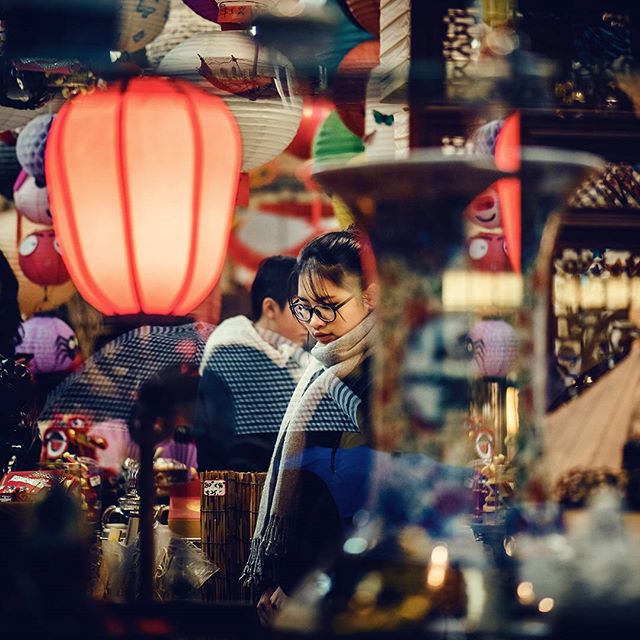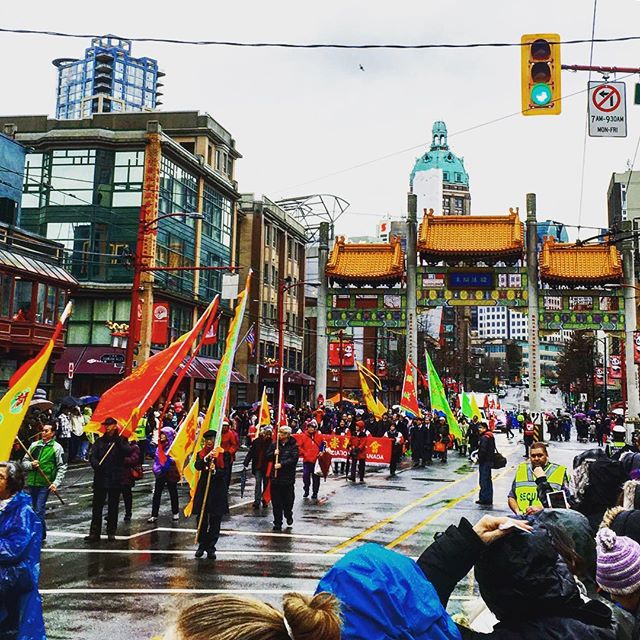The astounding yet comparably reduced crowd of 3000+ participants and 10,000 more in the audience braved the rain at the 2017 Chinatown Spring Festival Parade. We want to thank the Chinese Benevolent Association (CBA) for organizing the 44th festival, filling the streets with people, hope and cheer, and most importantly honouring a respect for cultural traditions in Chinatown that we have seen in decline of over the years. Parading together at a signature Vancouver Chinatown event lets visitors and younger generations draw lineage or connect with passed on ancient traditions, cultural heritage, and appreciate local foods and businesses.
Around mid- January to early February each year, depending on calendar calculations, marks the time for celebration! This includes mythical creatures dancing, red decorations, red clothing, cute red paper envelopes stuffed with chocolate coins or money, and no shortage of glutinous foods that let us celebrate together and remind us of a giving and loving time that is the Chinese Lunar New Year. A simple explanation why red is used everywhere is because it symbolizes good luck in traditional Chinese culture.
At Chinatown Today, the first thing we do is to eat special dishes together with our family members on new year’s eve following very specific instructions on how food should be prepared, presented, and handled. For instance, Chinatown Today member Louis, learned more about traditional Chinese new year dinner customs while feasting with his Chinese-French friends. They sent him to Money Foods to buy three sorts of meats (uncut!), and upon arriving to the party he realized that his friends already had meat, and that his was only meant as an offering for the house spirits because animals had to be whole. He was disappointed he couldn’t eat the meat, but enjoyed learning about the tradition.
Also in the Chinatown neighbourhood is Chef clement Chan from Torafuku who shared his favourite new year dish recipe with CBC News for braised Chinese mushrooms.
“Lunar New Year was always a busy time of preparing meals for the one occasion each year where everyone in the family sits at the same big table. That means a lot of food has to be prepared. Each dish has its own special significance for the occasion and the desire for good luck in the new year.” – Clement Chan, Torafuku
The Year was a terrifying beast (mythologically)
Many feared the Year. The history of Chinese New Year celebrations behind the gift giving gestures is a tale often forgone. Legends say that a merciless beast called the 年 (m: nian; c:niin – translation: Year) went about villages eating people and especially tiny children. People feared the evil 年 and would decidedly hide from it during this dangerous time. However, in the eyes of one fearless monk and the village children hiding seemed silly, thinking, “There must be a better way to deal with the 年. There’s many more of us to form a power much greater than the singular 年.”
The courage from this bootstrapped team later led to the discovery of 年’s weaknesses. It happens that the 年 hated the colour red and loud noises, resulting in the lengthy drumming and explosions of firecrackers meant to scare off the harmful intentions of the creature. Elders would give children red envelopes to keep them safe for the rest of the year, and strips of red paper were pasted on doors of homes and buildings as blessings.
This tale reminds us of how Chinatown was formed, and how much we appreciate the societies and groups that have demonstrated a resiliency to protect, support and strengthen the community in the past. It’s easy to miss the reason why the Chinese New means even for some people who are born Chinese.
The story’s relevance to Chinatown Today
A quote from a friend
“[It’s] a moment of recentering and regrounding; to remind yourself of what is important and who has been/is/will be there with you for the new year to come.” – (Andy Su; medium @buzzlightyearsu)
With so much noise and colourful things at the annual Chinese New Parade parade, it can be easy to miss the reason what Chinese New Year means even for people who have Chinese roots.
This tale reminds us of how Chinatown was formed, and how much we appreciate the societies and groups that have demonstrated courage and resiliency to protect, support and strengthen the community in the past. Witnessing seniors and adults from different Chinatown clans, benevolent societies and athletic clubs join together or in their own respective groups at the annual Chinatown parade allows us to at least mentally trace back two centuries and remind ourselves of the social fabric that has formed the neighbourhood. Change takes a lot of people to stand up for what are shared values and needs. All the challenges a community faces especially when its history of growth are experiences noteworthy and inspiring for future community building tactics.
Otherwise, having to relearn generation after generation what being a minority group in a western society means could get increasingly confusing. Cultural and historic meanings can get lost when older generations pass on and buildings are torn down and a neighbourhood solely modernizes as a place for commercial purposes.
Lunar New Year festivals, concerts and parades tend to take place in cities and spaces that have historical ties to Chinese immigration. The knowledge, traditions, and rituals that have been passed on from generations can be visualized at events like the parade. Athletic teams have practiced tirelessly, training others to grow up with the art and skills needed to control lions and dragons that inspire us every new year. Restaurants along the parade strip have been baking Chinese pastries with recipes from their families or culinary experiences in China, simultaneously demonstrating how the Chinese community has expanded and contributed to our local Canadian food system. Chinatown has done what it can to preserve important elements of Chinese culture that early immigrants want to share with the accepting multicultural country they believed they have settled into. No matter how much the space has changed over the years, it’s clear that the idea of change is not feared, but a loss of culture and community solidarity.
While bright and massive lions shake and shiny sequined dragons loop through the air, the Chinatown athletic groups are circling around and pausing at some of the most historically significant landmarks and streets like Pender, Keefer, Gore, and Carral. This seemingly simple dance is an opportunity to both new and old visitors another chance to discover cultural heritage expressed by the community through architecture, infrastructure, and maybe even nostalgia. So when the lions rip away at the lettuce in front of local traditional business storefronts, as well as the new retailers large and small, they’re just trying to chew away the bad stuff so there is room for better things to come. And as we’re accepting red envelopes, new year gifts, or making a point to enjoy a meal with our families and friends, we’re honouring our immigrant ancestors who have sojourned overseas to settle in a place now we refer to as home.
How can you get involved?
Join an athletic club. Learn kung fu basics: see our sports directory
Continue celebrating the year of the Rooster/Chicken at our local bars with a cocktail or two. See our directory for more options.




















































